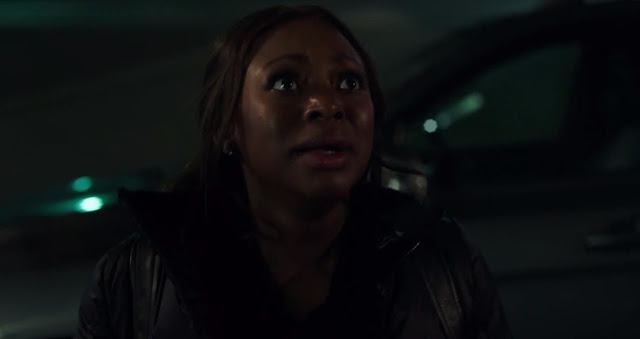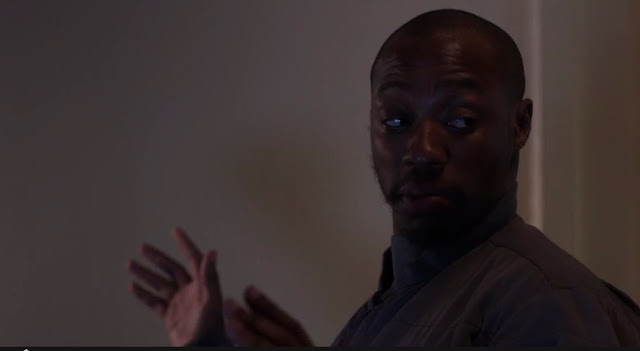Textual Analysis of Power ( TV Drama)
Camera-angle, size and movement
In this episode of Power, from 42 minutes onwards, what I can
see is that the camera is hand held. The meaning of this is to create tension,
to show the fast pace and to make it more realistic. It also allows the audience
to feel like they are in Tariq’s/Ghost’s/Tasha’s/Tommy’s shoes.
In this part
of the episode there are a lot of close up shots to show each of the characters
emotions. For example, when Tariq was about to shoot Ray, they used a close up
shot of Tariq’s face to capture his fear but also his determination. I also saw
the revenge and him wanting to kill Ray because of the murder of his sister.
 |
Also in this
episode of ‘Power’, long shots are used often. Long shots are used to create
the feeling that the audience is with the character at that particular time in
the scene. The audience see what the character sees. For example, there was a
longshot used when Tariq was walking into Ray’s house and you can see what is
in front of him. I can see a long, narrow corridor. At the end of the corridor,
Ray is packing money into a gym bag and I gathered that he is going to run
away. The shot moves closer and closer and what I think this does, is make us
feel like something is going to happen, Tariq has the gun and a sense of
suspense is created.
When Tariq
got to the end of the corridor he had the gun pointed at the back of Ray’s
head, and Ray started to provoke Tariq into shooting him. In this particular
part of the episode there are a lot of shot reverse shots to see both of the
characters emotions. It was also an eye level angle and over the shoulder angle
so the emotion on Tariq’s face was shown to the audience. This was important
because he is the main character in this episode, also the audience want to see
how he reacts to shooting someone as it is not a normal thing for a young boy
to shoot someone. It is a life changing event.
Editing including any SFX
Editing can
include cutting from one scene to another. Cutting may change the scene,
compress time, vary the point of view or build up an image or idea. In ‘Power’,
there was a shot where the camera was hand held and the cutting rate was faster
so that we can feel like Ghost was running quickly. We are shown Ghost trying
to break into the door and the scene is then cut to Tariq trying to break inside
the house without Ray knowing. The speed
at which the cuts happen is very fast and very intense, which suits an
action/murder scene, which creates a feeling of energy and exhilaration. This
also shows what’s going on in Tariq’s mind and what’s going on in Ghost’s mind,
varying the perspective. Ghost wants to get to Tariq as quickly as possible so
that makes the audience feel that he needs to speed up. Cutting like this
allows us to see both actions happening at the same time.
Sound-diegetic, non-diegetic
Diegetic
sound is when you can hear a sound that the characters can hear in the scene.
For example when Tariq shot the guy, you could hear it even though you couldn’t
see it. This is diegetic because it would have been what you could hear if you
had been in the house. This creates a dramatic sense of shock for the audience.
There is also a diegetic sound of a police car which gives a sense of worry and
panic because they think that they are going to get caught. The audience feel
exhilarated and anxious and want the characters to get out of the house as soon
as possible.
At the same
time there is non-diegetic sound which is music. The music is fast paced and
dramatic which gets the audience on the edge of their seat. The lyrics of the
music for example ‘Murder on your screen death is not a myth’ and ‘click clack
of a bomb over Baghdad’ gives the impression that something is going to happen
and adds to the atmosphere of the scene.
As Ghost is
going up the stairs, the music plays, when the gunshot fires the music stops
and there is silence. This silence represents the end of something big, the end
of someone’s life.
Mise-en-scene: location, costume, props, lighting
Mise- en -scene means what we can see in the scene, what
creates the atmosphere – lighting props etc. For example when Tariq was walking
into Ray’s house, a panning shot is used to show the setting that Tariq was in.
We can see a table full of stolen goods this gives a sense that this place is
not an average house that a teenage boy would walk into on a daily basis.
Lighting can
also add to the atmosphere. In this case, the house that Tariq had just walked
into was very dim, dark and gloomy. Which makes the scene more intense and
scary. Tariq didn’t seem scared or flinch because he was consumed by vengeance
and all he saw was black.
The prop
used in this scene is a gun, essentially having a gun in a movie/TV drama or in
any situation makes the audience feel scared/terrified. Having a gun in this
scene shows the audience how serious Tariq is about killing Ray. In Power guns
are shown/used regularly. When Tariq was pointing the gun at Ray you can see
that his hands were trembling and shaking this showed the audience that he was
scared but still determined to kill.











Comments
Post a Comment